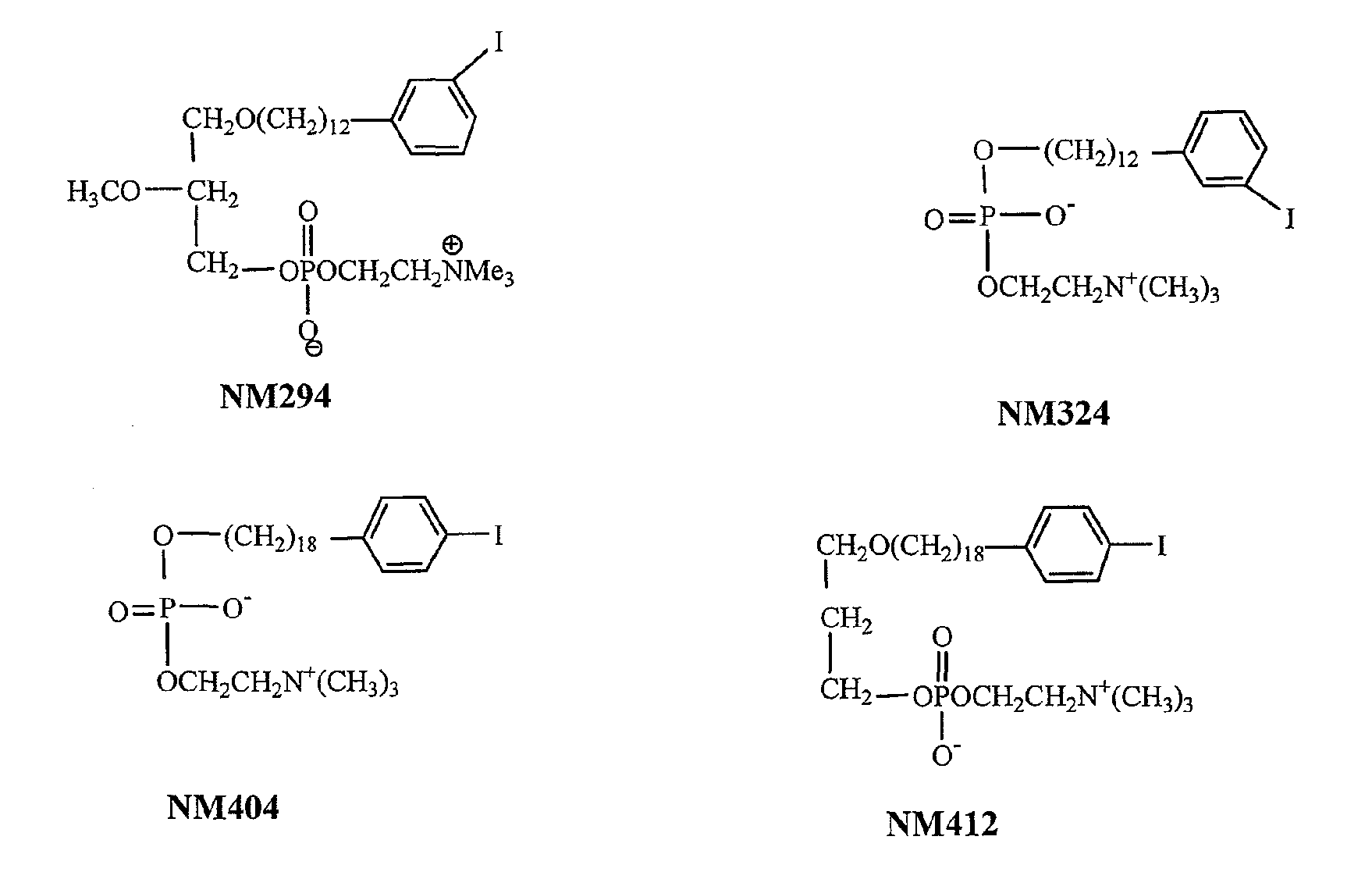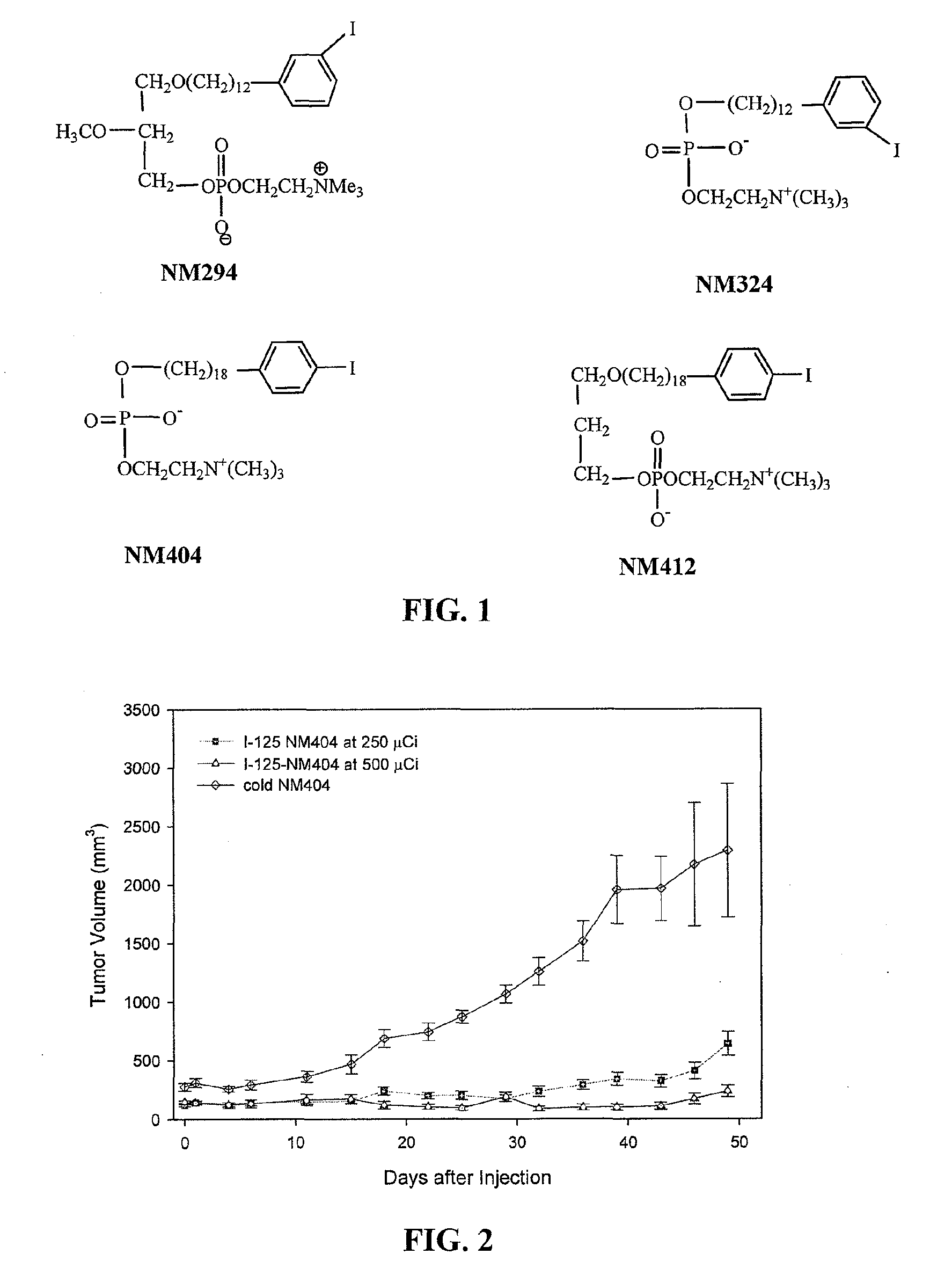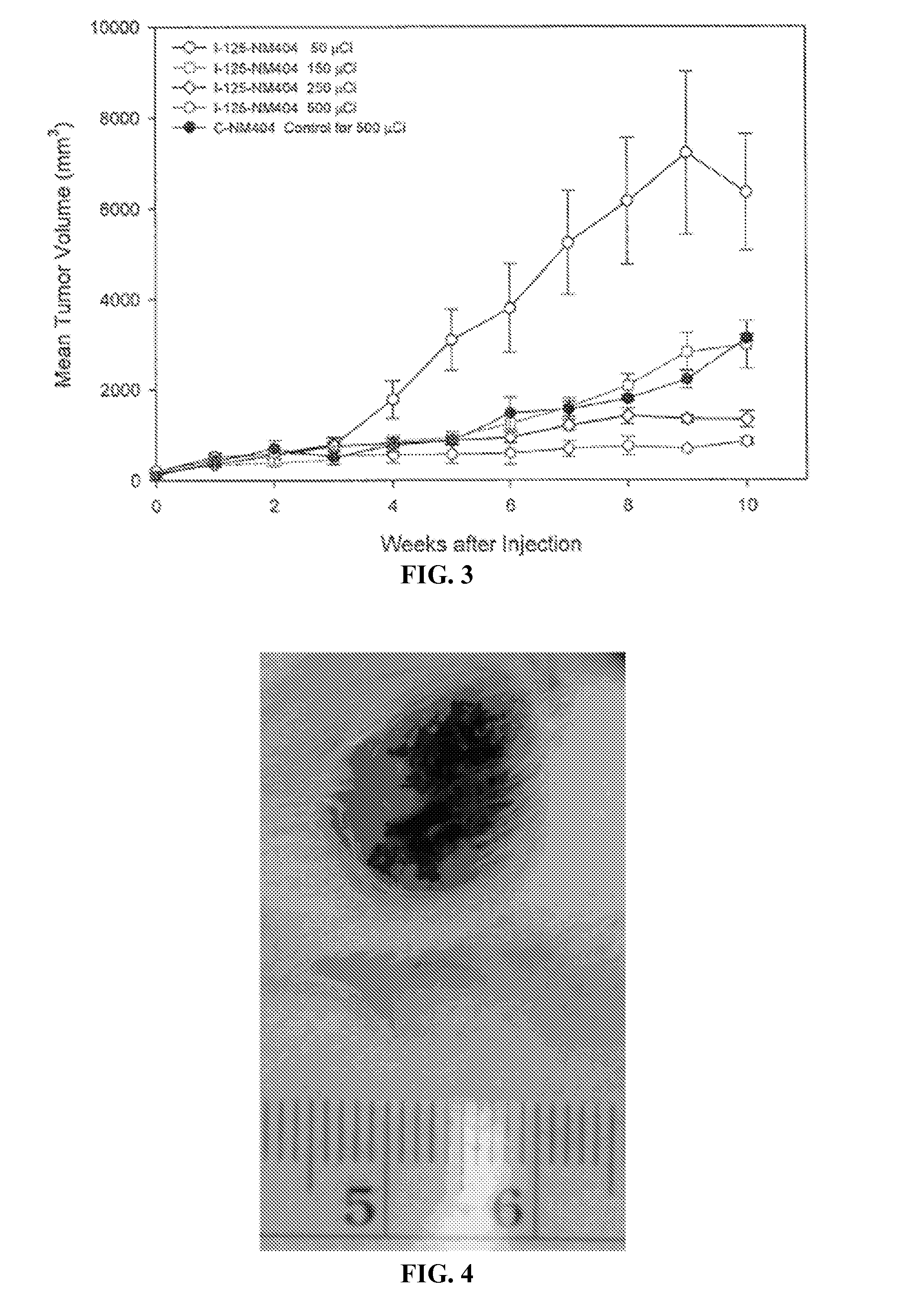Compositions of phospholipid ether boronic acids and esters and methods for their synthesis and use
a technology of phospholipid ether and esters, which is applied in the field of boronic acids and esters of phospholipid ether (ple) analogs, can solve the problems of short time frame for use, high background in the kidneys and bladder, and inability to approach the specificity and versatility of ple and apc analogs, so as to reduce the growth of cancer
- Summary
- Abstract
- Description
- Claims
- Application Information
AI Technical Summary
Benefits of technology
Problems solved by technology
Method used
Image
Examples
example 1
18-[p-(Dihydroxyboryl)phenyl]octadecyl phosphocholine (2)
[0113]NM404 (72 mg, 0.113 mmol), bis-(neopentylglycolato)diboron (60 mg, 0.266 mmol), anhydrous potassium acetate (34 mg, 0.346 mmol) and PdCl2(dppf) (5 mg, 0.0061 mmol) were placed in a 4 ml vial and dried under high vacuum for 30 min. The vial was filled with nitrogen and methanol (1.5 ml, degassed by three freeze-pump-thaw cycles) was added. Reaction mixture was stirred at 50° C. for 2 h, then evaporated, redissolved in chloroform and loaded onto silica gel column. The column was eluted first with stepwise gradient of CHCl3-MeOH (90:10, 80:20, 50:50) and finally with CHCl3-MeOH—H2O (65:25:4) to give the product as a white powder, 51 mg (81%). 1H-NMR (400 MHz, CDCl3—CD3OD 1:1): 7.53 and 7.19 (two d, J=8 Hz, 2H each, C6H4), 4.26-4.20 (br m, 2H, POCH2CH2N), 3.87 (q, J=6.6 Hz, 2H, CH2OPOCH2CH2N), 3.61-3.58 (m, 2H, CH2N), 3.22 (s, 9H, N(CH3)3), 2.61 (t, J=7.7 Hz, 2H, ArCH2), 1.68-1.58 (m, 4H, ArCH2CH2 and CH2CH2O), 1.42-1.24 (m,...
example 2
18-[4-(4,4,5,5-Tetramethyl-[1,3,2]dioxaborolan-2-yl)-phenyl]-octadec-1-yl phosphocholine (3)
[0114]Method A: NM404 (51 mg, 0.080 nmol), bis-(pinacolato)diboron (49 mg, 0.192 mmol), anhydrous potassium acetate (24 mg, 0.24 mmol) and PdCl2(dppf) (1.3 mg, 0.0016 mmol) were placed in a 4 ml vial and dried under high vacuum for 30 min. Vial was filled with nitrogen and methanol (1.5 ml, degassed by three freeze-pump-thaw cycles) was added. Reaction mixture was stirred at 50° C. for 2.5 h, then evaporated, redissolved in chloroform and loaded onto silica gel column. The column was eluted first with stepwise gradient of CHCl3-MeOH (90:10, 80:20, 50:50) and finally with CHCl3-MeOH—H2O (65:25:4) to give the product as a white powder, 27 mg (53%). 1H-NMR (400 MHz, CDCl3—CD3OD 1:1): 7.69 and 7.20 (two d, J=7.8 Hz, 2H each, C6H4), 4.26-4.20 (br m, 2H, POCH2CH2N), 3.87 (q, J=6.6 Hz, 2H, CH2OPOCH2CH2N), 3.61-3.58 (m, 2H, CH2N), 3.22 (s, 9H, N(CH3)3), 2.62 (t, J=7.7 Hz, 2H, ArCH2), 1.68-1.58 (m, 4H...
example 3
Improved Synthesis of Long Chain ω-(p-Iodophenyl)alkyl Alcohols and Corresponding Phospholipid Ethers and Alkyl Phosphocholines Including NM404
[0117]Previous reports from the laboratories of R. E. Counsell and J. P. Weichert described the remarkable capacity of radioiodinated phospholipid (PLE) and alkyl phosphocholine (APC) analogs NM294, NM324, NM404 and NM412 (FIG. 1) to be selectively retained by a variety of human and animal tumors in xenograft and spontaneous tumor rodent models.
[0118]The reason for the retention of PLE and analogs in cancer cells remains unknown. Without being held to any particular theory, however, the prevailing hypothesis, is that radioiodinated PLE and APC analogs become trapped in tumor cell membranes because of their inability to be metabolized and eliminated. On the other hand, such lipid molecules are metabolized and cleared by normal tissues, including the liver. Support for this hypothesis was found when lipid extraction of tumors following administ...
PUM
| Property | Measurement | Unit |
|---|---|---|
| temperature | aaaaa | aaaaa |
| diameter | aaaaa | aaaaa |
| temperatures | aaaaa | aaaaa |
Abstract
Description
Claims
Application Information
 Login to View More
Login to View More - R&D
- Intellectual Property
- Life Sciences
- Materials
- Tech Scout
- Unparalleled Data Quality
- Higher Quality Content
- 60% Fewer Hallucinations
Browse by: Latest US Patents, China's latest patents, Technical Efficacy Thesaurus, Application Domain, Technology Topic, Popular Technical Reports.
© 2025 PatSnap. All rights reserved.Legal|Privacy policy|Modern Slavery Act Transparency Statement|Sitemap|About US| Contact US: help@patsnap.com



